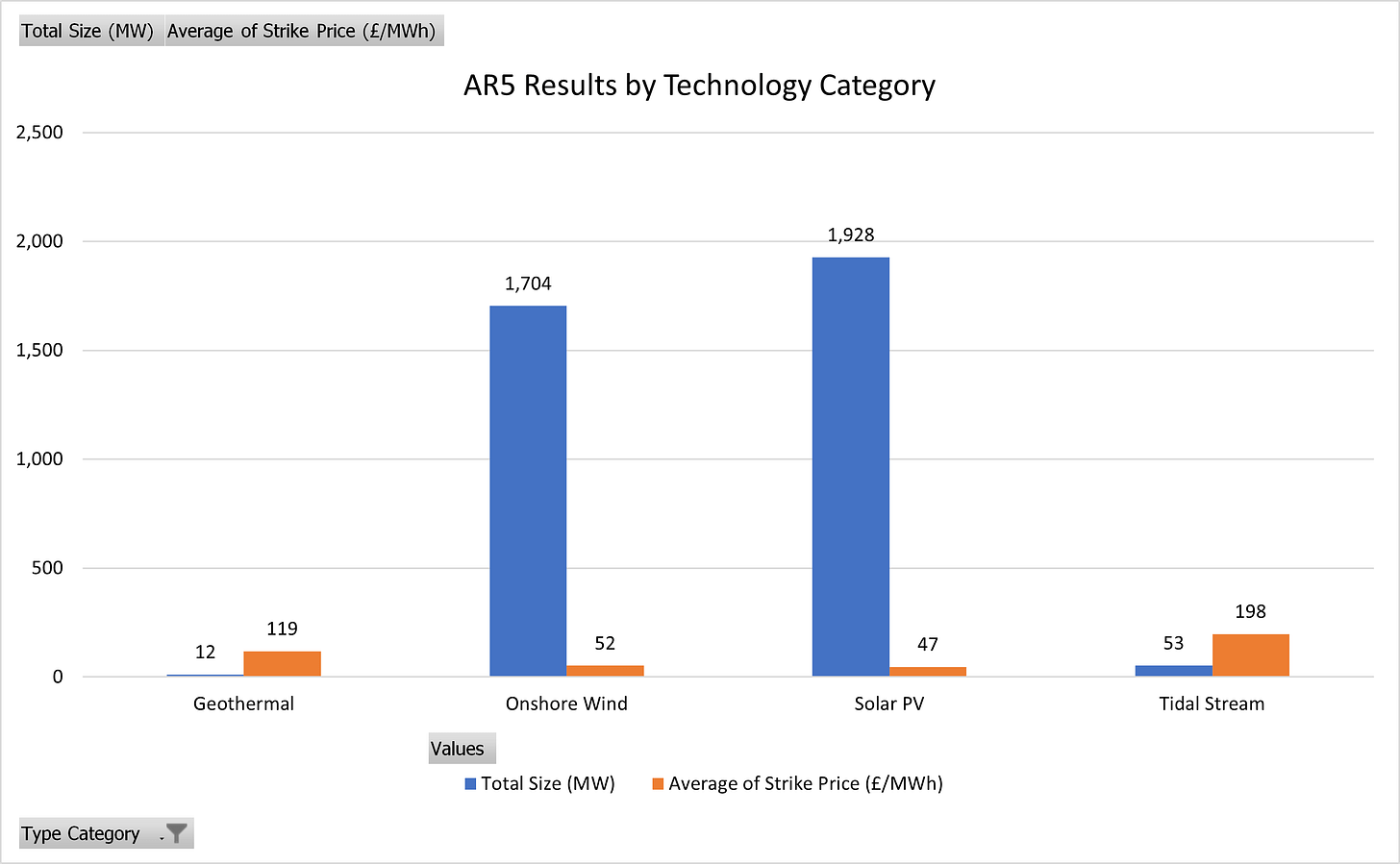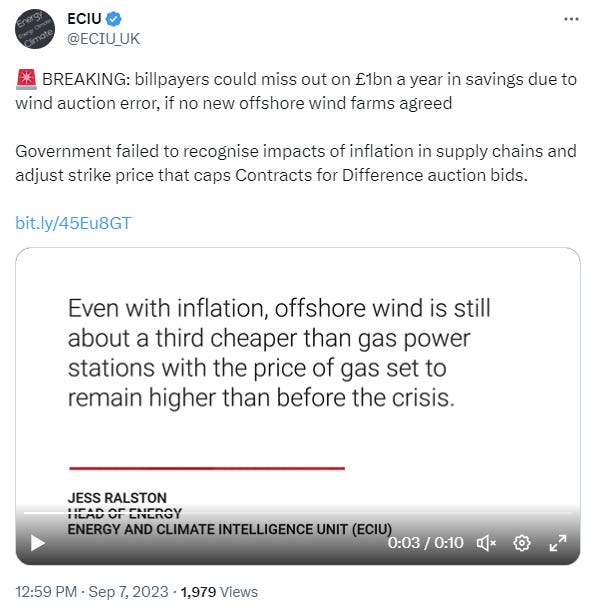AR5 Results Puncture Renewables Fantasy
Allocation Round 5 Results show Government Will Not Achieve Net Zero Targets
The truth is incontrovertible. Malice may attack it, ignorance may deride it, but in the end, there it is.
Winston ChurchillIntroduction
The results are in. Allocation Round 5 to award Contracts for Difference (CfDs) for renewable energy has concluded. The Government has announced which projects have been awarded subsidies and the guaranteed prices each project will receive. This article delves into the detail of the AR5 contract awards and what it means for the Government’s renewable targets. It’s not just offshore wind that is in trouble.
Allocation Round Five (AR5) Results
The Government announced the results of AR5 on Friday. Figure 1 shows my summary of the results announcement. As expected, there were no successful bids for offshore wind.
Three geothermal projects were awarded contracts for a total capacity of 12MW at an average price of £119/MWh at 2012 prices; this is around £160/MWh in 2023 money. Eleven tidal stream projects were awarded contracts at an average of £198/MWh (or ~£266/MWh at 2023 prices) for a total of 53MW of capacity. Far from cheap!
Onshore wind projects were awarded 25 contracts (including one Remote Island project) at £52.29/MWh (~£70/MWh in 2023 money) for a total of 1,704MW. All but one of the projects is in Scotland, with the other in Wales. All are expected to deliver in the 2025-2028 period.
Fifty-six Solar PV projects were awarded contracts at £47/MWh (~£63/MWh in 2023 prices) for a total of 1,928MW of capacity. All but one of the solar projects are in England with one in Wales and are expected to deliver in the 2025-2028 period.
The real prices awarded are far higher than the Levelised Cost of Energy (LCOE) estimates for 2025 published by the Government earlier this year, see Figure 2.
The Government estimated £44/MWh in 2021 prices for onshore wind delivering in 2025 or ~£52/MWh in 2023 money. Yet they have awarded contracts at ~£70/MWh in this round. Similarly, they have awarded Solar PV contracts at £63/MWh in 2023 money compared to their estimate of £41/MWh, or £48/MWh in 2023 money, in their LCOE estimate. This further illustrates the magical thinking in the LCOE estimates that I highlighted here.
It is also worth remembering that onshore wind and solar are intermittent technologies so the effective capacity will be much lower than the headline figures and extra costs will be incurred to backup these technologies and balance the grid when the wind is not blowing or the sun is not shining. Last year, these balancing costs amounted to £4.1bn. At the time of writing, reliable gas is producing electricity at around £80/MWh and that includes punitive carbon taxes.
Implications for Net Zero Targets
These results make life very difficult for Claire Coutinho, the new Secretary of State at the Department of Energy Security and Net Zero (DESNZ) aka the Department for Oxymorons. Even before this announcement the Government was not on track to meet its Net Zero targets, as can be seen in Figure 3 below.
This shows the combined contract awards for AR3 (2019), AR4 (2022) and AR5 (2023) compared to the capacity required to hit the Government’s targets for 2030. The blue target bar is the annual target to reach the Government’s targets for 2030. The orange target bar is four times the annual target because the contract awards for AR3 and AR4 covered four years. The targets are taken from the Government’s Powering Up Britain (Table 2.2) (for onshore wind and solar) and its more recent Offshore Investment Roadmap for offshore wind.
Offshore wind fell well short of the target in AR3 and AR4 and delivered nothing at all in AR5. The picture is even worse because Vattenfall pulled out of the 1.4GW Norfolk Boreas development in July. Norfolk Boreas was awarded a contract as part of AR4, so offshore wind is even further behind than indicated.
Onshore wind delivered slightly more than required in AR5, but this did not make up the shortfall in AR3-4. I have not shown figures for Solar in AR3-4 because the regime for solar was different back in 2019. However, for AR5, solar PV fell well short of what is required to hit the 2030 target.
The shortfalls are illustrated further by the looking at the trend in installed capacity since 2009 and comparing them to the 2030 targets as shown in Figure 4 below.
Wind Plans Blown Away
The solid blue line shows the actual installed capacity of onshore wind since 2009. The rate of new installations has fallen since 2017. We currently have 14.8GW of onshore wind capacity. The Government’s 2030 onshore wind Net Zero target in its Powering Up Britain (Table 2.2) document is 27GW, shown as the blue square. This is about 1.8 times the current capacity. The blue dotted line shows the linear trend out to 2030. If we got back to trend, we might expect to get to around 24GW of installed capacity, about 3GW short of the target shown by the blue square. From 2022 to 2030 1.5GW of new capacity needs to be delivered each year. They have awarded 1.7GW, slightly ahead of the required rate, but much more needs to be awarded to meet the target.
Offshore wind capacity is shown on the solid green line. The Government’s target of 50GW in its Offshore Wind Net Zero Investment Roadmap (including up to 5GW of floating offshore capacity) is shown by the green square and is some 3.6 times the current 13.8GW of installed capacity. Current capacity is slightly above the dotted green trend-line because of the new developments that came online last year. However, even if the trend could be maintained out to 2030, there would still be a gap of over 30GW compared to the Government’s target. The chances of even achieving the trend are slim. As previously mentioned, Vattenfall pulled out of the 1.4GW Norfolk Boreas development in July and put Norfolk Vanguard East and West, with a combined capacity of 2.8GW “under scrutiny.” Of course, no offshore wind contracts were awarded in AR5 so realistically, the 2030 target is beyond reach.
Shadows Over the Solar Power Plan
The yellow solid line is the actual Solar PV generating capacity over time. The yellow dotted line is the linear trend extrapolated out to 2030. The yellow triangle is the Government’s target of 39GW. This is 2.7 times the current 14.7GW installed capacity. The rate of new installations has pretty much flat-lined since the boom of solar installations from 2012 to 2017. There would need to be a big boost in installation rates just to get back to trend. Even if that is achieved, that would only deliver ~27.6GW by 2030. Of course, AR5 has delivered less than the annual target, so it is pretty safe to say that the Government’s solar ambitions are not going to be met either.
Impact on Energy Security and National Risk Register
Last month, the Deputy Prime Minister Oliver Dowden unveiled the National Risk Register and said that energy security was a “rising risk.” He touted wind power as a means of providing “secure, low-cost and clean energy.” Wind power is a totally inappropriate mitigation for such a risk because it is intermittent and so cannot be relied upon to deliver power when we need it. Last week, our 28GW wind fleet produced very little. At one point wind output was as low as 0.1GW. We had to burn gas, coal and trees to keep the lights on. See Figure 5.
It is clear that wind is not reliable and in no way enhances energy security. In fact, more wind capacity probably increases the risk of grid failure.
So, perhaps perversely, the risks to the grid reduce because of the AR5 auction debacle, but only if they keep reliable generators like coal running.
Commentator Reaction to AR5 Auction Debacle
Of course, the usual suspects were dissembling about the true costs of wind power and criticising the results of the auction even before they were published. Getting their excuses in early so to speak. The Energy and Climate Intelligence Unit (ECIU) said on Thursday that consumers are missing out on £1bn per year of savings because of the “auction error.” They even claimed that offshore wind is a third cheaper than gas (see Figure 6).
As discussed here, current offshore wind strike prices are typically above £160/MWh, compared to current gas at around £80/MWh (see Figure 7).
Emma Pinchbeck of EnergyUK claimed a renewables-led grid remains the cheapest option (See Figure 8).
The thing is, if offshore wind really was so much cheaper than gas, the wind farms would get built anyway and without subsidy. Their claims are completely absurd.
Former head of energy strategy at BEIS and self-styled “energy geek” Adam Bell thinks the AR5 results are a “disaster” and wants the whole process handed over to the Future Systems Operator (FSO) (see Figure 9).
FSO is the new name for National Grid ESO that does not understand EROEI and is pushing fantasy scenarios for the grid that will result in us all being poorer and colder. Even though the Government is incompetent, at least they are subject to the ballot box. Handing such an important function to an unelected, unaccountable body would be disastrous.
Conclusions
I have been warning for some time that wind power is far more expensive than we are being told (see here, here and here) and that the wind industry is in trouble. This is obvious to anyone who takes the time to delve into the detail of Government and lobbyist publications. But as we have seen, it’s not just wind in trouble. Solar adoption is running behind target rates too. Yet, the Government has persisted with the renewables fantasy. That fantasy has now been punctured.
Clearly, the Government’s 2030 Net Zero targets are not going to be met. It is inevitable that the targets will be abandoned. Wind is simply too expensive and unreliable to form the backbone of the grid. Solar is pointless at UK latitudes because it produces most on summer days when demand is low and nothing at all on winter evenings when demand is highest. There is still time to design an alternative grid around nuclear and gas that will deliver cheap, reliable and secure energy with much reduced emissions compared to today. This will be best delivered by resuming fracking for our own gas to reduce reliance upon the world’s despots. By delivering energy abundance, we can also avoid the totalitarian nightmare that awaits us with state control of domestic appliances and criminal penalties for not having the right energy performance certificate.
It is time the Government started listening to people with STEM degrees and stopped listening to eco-activists and lobbyists who have no clue about physics, energy or economics. The time to change course is now.
If you have enjoyed this article, please share it with your family, friends and colleagues and sign up to receive more content.











And now SSE illustrates my point perfectly by announcing it won't build any more onshore windfarms.
https://www.telegraph.co.uk/business/2023/09/09/britain-wind-power-developer-sse-onshore-offshore-farms/
The time to change course IS now. That will necessarily mean repealing May's 2019 Net Zero statutory instrument target, preferably amending or repealing the climate Change Act 2008 - BEFORE the next election. It's not going to happen. The present government is going to keep going with the renewables fantasy, hand over power to Labour in a year or so's time who will then double down on the renewables fantasy with mad eco zealot Ed Miliband at the helm and fifth columnist Starmer in overall control, reporting directly to the WEF. Result: total economic destruction and social disintegration of UK PLC. The fake Conservatives are not going to save us in the few hours we have left before midnight.